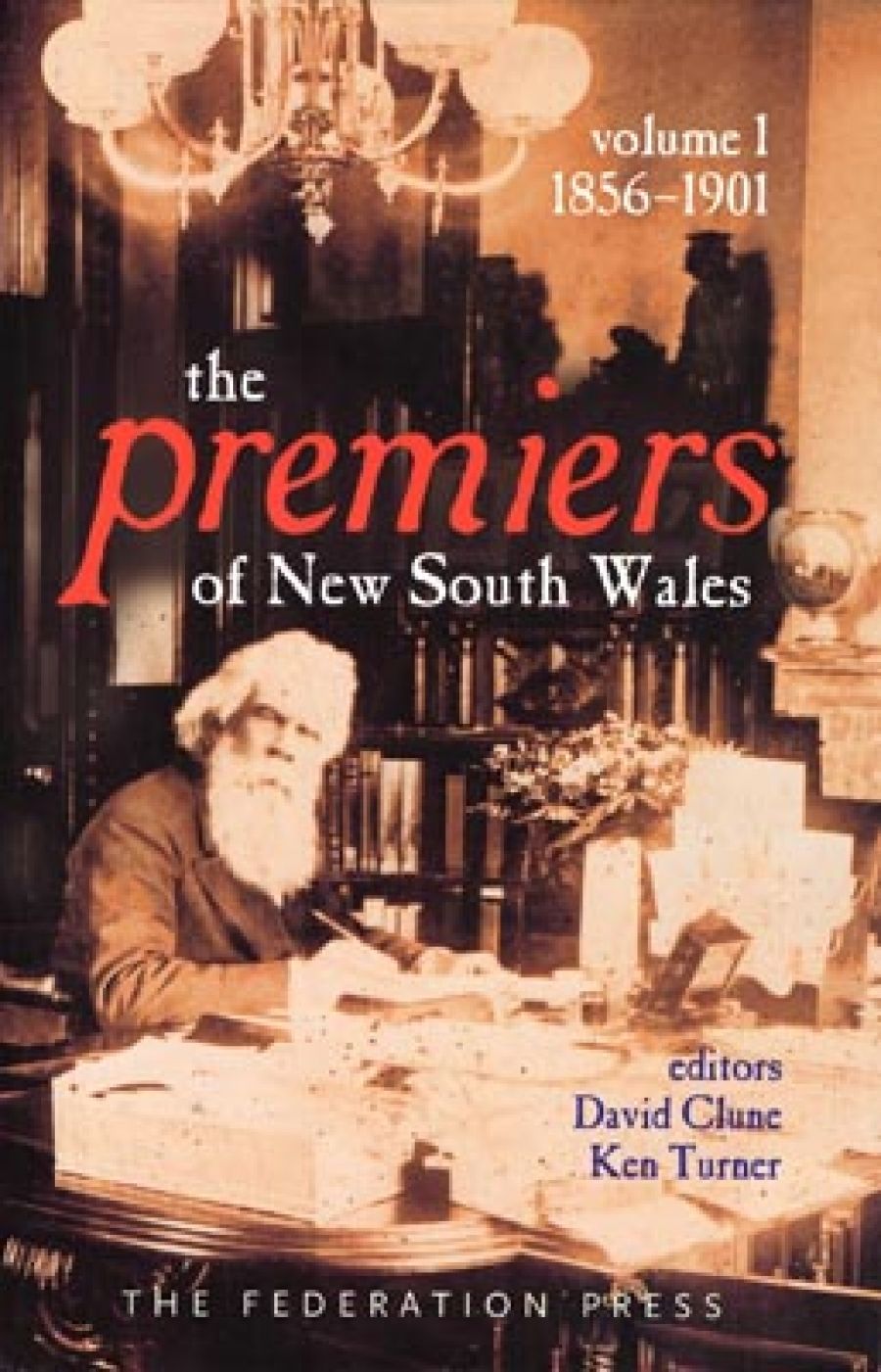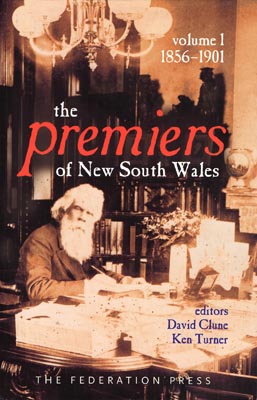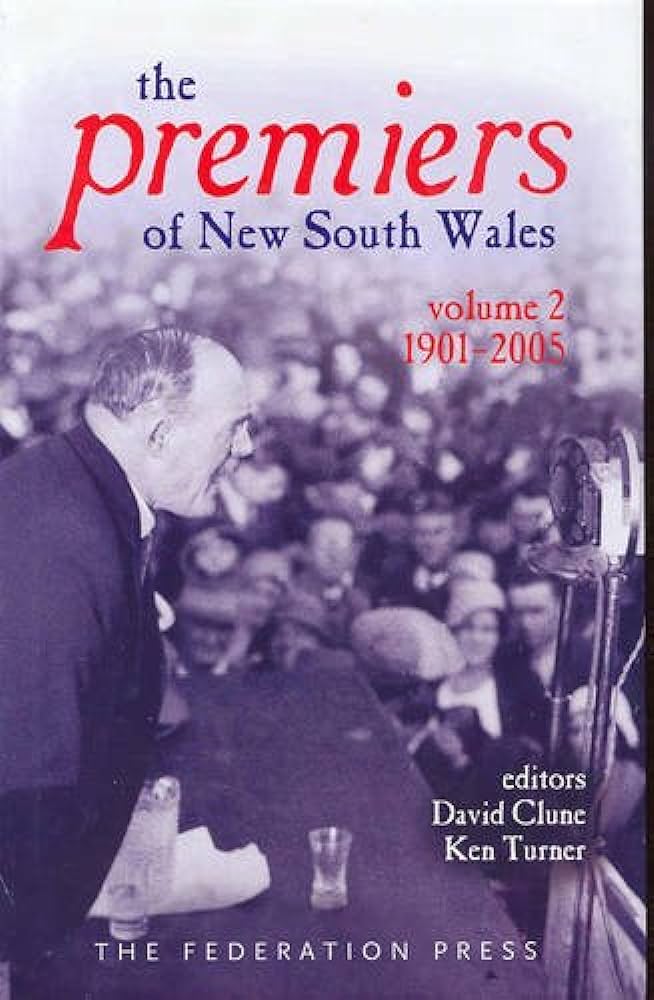
- Free Article: No
- Contents Category: Biography
- Custom Article Title: Washing the blood off the wall
- Review Article: Yes
- Article Title: Washing the blood off the wall
- Online Only: No
- Custom Highlight Text:
The problem with many ‘big occasion’ publications is that they are written for the occasion rather than for an audience. This collection – the first reference work to cover all the premiers of New South Wales from 1856 until July 2005 – has been published to coincide with the one hundred and fiftieth anniversary of responsible government in New South Wales. Happily, however, The Premiers of New South Wales displays none of the failings typical of other ‘landmark’ volumes. On the contrary, this is a valuable and relevant work that merits the interest of non-specialist readers. The authors have profiled the premiers in their social and personal contexts, as well as in their political environments. This extends the appeal of the collection and adds considerable interest. Together, the two volumes provide valuable insights into the evolution of New South Wales from a colony to a state.
- Book 1 Title: The Premiers of New South Wales Volume 1
- Book 1 Subtitle: 1856-1901
- Book 1 Biblio: Federation Press, $39.95 hb, 272 pp
- Book 1 Cover Small (400 x 600):

- Book 1 Cover (800 x 1200):

- Book 2 Title: The Premiers of New South Wales Volume 2
- Book 2 Subtitle: 1901-2005
- Book 2 Biblio: Federation Press, $39.95 hb, 548 pp
- Book 2 Cover Small (400 x 600):

- Book 2 Cover (800 x 1200):

Volume One, which covers the premiers who served until Federation, makes it clear that the politics of colonial New South Wales were even less predictable than those we are accustomed to today. The colonial parliament was dominated by loose and ill-disciplined factions; the party system that we know today did not mature until after Federation. The factions grouped together in shifting alliances, and sudden defections from their ranks was common. Typical of such opportunists were John Robertson and Henry Parkes, each of whom served as premier for five separate periods, sometimes as coalition partners and sometimes as opponents. A later premier, James Martin, informed parliament in 1865 that he would ‘deeply regret’ to see Parkes ‘belong to any administration in this country’, yet within twelve months the two men had united to form a coalition government. Governments fell with extraordinary ease: four of the first six parliaments did not make it to halfway through their allotted terms. One can imagine the ‘voter fatigue’ of the nineteenth-century elector in New South Wales.
The electors themselves sought in the political process the resolution of issues as diverse as rural land ownership, bushrangers and (after 1890) hardship caused by the Depression.
Despite the difficulty of maintaining stable government, most of the premiers could claim to have introduced legislation or administrative measures of lasting benefit to the colony. Some of the notable achievements, besides the establishment of responsible government itself, included Charles Cowper’s passage of the Electoral Act 1858, Parkes’s public works programme (including construction of the difficult railway line over the Blue Mountains), George Dibbs’s protection of deposits during the banking crisis of 1893, George Reid’s establishment of the State public service and William Lyne’s industrial and women’s suffrage legislation. One issue that no premier of the period was able to finalise was that of rural land ownership and the rights of pastoralists; it would be the following century before this issue faded from political prominence in New South Wales. The most interesting of the premiers themselves were Martin (the only man to have attained the offices of both premier and chief justice of the Supreme Court), Parkes (who would go on to lead the Federation movement) and Dibbs (who had served time in prison before becoming premier). Those whom the authors have rescued from oversight include Stuart Donaldson, the first premier of New South Wales (he served for less than three months) and Reid, whose importance to the campaign for Federation has been overlooked by some historians.
Volume Two contains some surprises as well as familiar material. I must confess that, in reading this volume, I ‘dipped in’ at various places that caught my interest. The profiles of the most recent premiers were the first to be consulted, followed by notorious but ill-understood earlier subjects such as Jack Lang and Robin Askin. The volume suffers little from such an approach; indeed, as each profile is self-contained, reading the chapters in sequence can be a touch repetitive, as many of the accounts overlap (although, as the editors note, differences in the account of a particular individual can be instructive).
Politics in New South Wales, in the early part of the twentieth century, was notable for the establishment of the party system. While this eventually improved the stability of governments, the early workings of the system were challenged by the bitter debate over conscription that split the Labor party in 1916 and that precipitated a realignment of the non-Labor parties (later to become the Liberal-led coalition). Subsequently, there were some impressive achievements. Under the government of Charles Wade, New South Wales became the first jurisdiction in the world to establish a non-contributory invalid pension. The same government also passed legislation to establish minimum wages, introduce workers’ compensation and regulate food purity. James McGowen improved access to universities and established state businesses such as brickyards and metal quarries; William McKell established the Housing Commission and government-subsidised housing during the postwar period; Joe Cahill was largely responsible for the Sydney Opera House.
The profiles of the more recent premiers are bound to attract some controversy, since many readers will have their own (possibly inconsistent) impressions of these politicians. It was possibly premature to have profiled Bob Carr – the longest-serving premier in the history of New South Wales – since the ongoing effects of his later policies are still unclear. I was disappointed that the profiles of Neville Wran and Barrie Unsworth were written by former colleagues of the subject (in the former case Graham Freudenberg, Wran’s former speechwriter; in the latter case Rodney Cavalier, a Cabinet minister under Unsworth). While this has produced a few telling insights (including Wran’s classic attitude towards Cabinet disagreements: ‘Now let’s wash the blood off the walls and grin when we go out, and stick together’), the suspicion of partiality is always present and the writing does not remove it. Freudenberg asserts that the Darling Harbour urban renewal project was Wran’s ‘lavish and lasting legacy to the people of Sydney’; the project was arguably Wran’s legacy to himself, as a number of commentators observed at the time. Cavalier’s objectivity might also be questioned; his denunciation of the ‘machine men’ of Labor has a tinge of personal bitterness to it, and the blame he attributes to the party machine for Unsworth’s massive 1988 loss sits uneasily with the fact that it was the machine that elected Unsworth. (Cavalier left office after the 1988 loss.)
These exceptions aside, the editors have struck an appropriate balance between scholarship and readability; the profiles are informative and well researched without being overwhelming to the average reader. To say that the collection is ‘hard going’ in parts is merely to accept that some of its subjects were less colourful than others —and many of them were colourful. The publication fills an important gap in Australian political history and will be of continuing relevance.


Comments powered by CComment